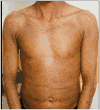Systemic retinoids in the management of ichthyoses and related skin types
- PMID: 23384018
- PMCID: PMC3884695
- DOI: 10.1111/j.1529-8019.2012.01527.x
Systemic retinoids in the management of ichthyoses and related skin types
Abstract
The term retinoid includes both natural and synthetic derivatives of vitamin A. Retinoid-containing treatments have been used since ~1550BC by the early Egyptians. Treatment of ichthyosiform disorders with retinoids dates back at least to the 1930s. Early use of high-dose vitamin A demonstrated efficacy, but because vitamin A is stored in the liver, toxicity limited usefulness. Interest turned to synthetic retinoids in an effort to enhance efficacy and limit toxicity. Acetretin, isotretinoin and, in the past etretinate, have provided the most effective therapy for ichthyosiform conditions. They have been used for a variety of ages, including in newborns with severe ichthyosis and for decades in some patients. Careful surveillance and management of mucous membrane, laboratory, skeletal, and teratogenic side effects has made systemic retinoids the mainstay of therapy for ichthyosis and related skin types.
© 2013 Wiley Periodicals, Inc.
Figures








Similar articles
-
Systemic retinoids in chemoprevention of non-melanoma skin cancer.Expert Opin Pharmacother. 2008 Jun;9(8):1363-74. doi: 10.1517/14656566.9.8.1363. Expert Opin Pharmacother. 2008. PMID: 18473710 Review.
-
Vitamin D Deficiency After Oral Retinoid Therapy for Ichthyosis.Pediatr Dermatol. 2015 Jul-Aug;32(4):e151-5. doi: 10.1111/pde.12614. Epub 2015 Apr 27. Pediatr Dermatol. 2015. PMID: 25919493
-
Oral retinoids and pregnancy.Med J Aust. 1996 Aug 5;165(3):164-7. doi: 10.5694/j.1326-5377.1996.tb124895.x. Med J Aust. 1996. PMID: 8709884 Review.
-
[Teratogenic effects of vitamin A and its derivates].Arch Pediatr. 1997 Sep;4(9):867-74. doi: 10.1016/s0929-693x(97)88158-4. Arch Pediatr. 1997. PMID: 9345570 Review. French.
-
Diazacholesterol-induced ichthyosis in the hairless mouse. Assay for comparative potency of topical retinoids.Arch Dermatol. 1984 Mar;120(3):342-7. Arch Dermatol. 1984. PMID: 6703735
Cited by
-
Genetics and prospective therapeutic targets for Sjögren-Larsson Syndrome.Expert Opin Orphan Drugs. 2016 Apr;4(4):395-406. doi: 10.1517/21678707.2016.1154453. Epub 2016 Mar 10. Expert Opin Orphan Drugs. 2016. PMID: 27547594 Free PMC article.
-
Treatments for Non-Syndromic Inherited Ichthyosis, Including Emergent Pathogenesis-Related Therapy.Am J Clin Dermatol. 2022 Nov;23(6):853-867. doi: 10.1007/s40257-022-00718-8. Epub 2022 Aug 12. Am J Clin Dermatol. 2022. PMID: 35960486 Review.
-
Biodegradable Elastomers with Antioxidant and Retinoid-like Properties.ACS Biomater Sci Eng. 2016 Feb 8;2(2):268-277. doi: 10.1021/acsbiomaterials.5b00534. Epub 2016 Jan 6. ACS Biomater Sci Eng. 2016. PMID: 27347559 Free PMC article.
-
Isotretinoin Treatment for Autosomal Recessive Congenital Ichthyosis in a Golden Retriever.Vet Sci. 2022 Feb 22;9(3):97. doi: 10.3390/vetsci9030097. Vet Sci. 2022. PMID: 35324825 Free PMC article.
-
Retinoid-induced skeletal hyperostosis in disorders of keratinization.Clin Exp Dermatol. 2022 Dec;47(12):2273-2276. doi: 10.1111/ced.15382. Epub 2022 Sep 27. Clin Exp Dermatol. 2022. PMID: 35988035 Free PMC article.
References
-
- Fujimaki Y. Formation of gastric carcinoma in albino rats fed on deficient diets. J Cancer Res. 1926;10:469–77.
-
- Griffiths WA. Vitamin A and pityriasis rubra pilaris. J Am Acad Dermatol. 1982 Oct;7(4):555. - PubMed
-
- Frazier CN, Hu C. Cutaneous lesions associated with a deficiency in vitamin A in man. Arch Intern Med. 1931;48(3):507–14.
-
- Loewenthal LJA. A new manifestation in the syndrome of vitamin A deficiency. Arch Derm Syphilol. 1933;28(5):700–8.
Publication types
MeSH terms
Substances
Grants and funding
LinkOut - more resources
Full Text Sources
Other Literature Sources
Miscellaneous

